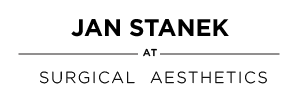Pectoral Implants by Jan Stanek at Surgical Aesthetics London
Increasing obsession with male physique and fitness has brought demand for enhancement of certain parts of the body which, in certain individuals, cannot be developed by natural means. Whether this operation should or should not be carried out remains controversial. It has to be said that some individuals may suffer psychologically by not having sufficiently developed pectoral muscles to the same degree as someone who has over-developed male breasts. Some may even have gross asymmetry of the chest wall which, in extreme cases, can be a severe deformity.
However, most males seeking this operation have reasonably symmetrical chests, work out regularly and, yet are unable to achieve the pectoral bulk they perceive as proportionate to their physique.
Pectoral augmentation is an operation designed to bring forward the existing major pectoral muscle, in the same way breast augmentation is designed to enlarge the female breast. There are some differences, however, the main being that the male chest has to remain looking male and not female.
The operation is usually carried out under general anaesthesia. An incision is made through the skin in the armpit, and a pocket made between the major pectoral muscle and the chest wall. The implant is made of solid silicone and should fit the pocket snugly, so that it cannot be moved during muscle contraction. It is important to realize that there is a limit to which this operation can augment the chest muscles. This is due to the fact that too large an implant may impede blood supply to the muscle and become subsequently extruded. Also, the small size of the incision will allow the surgeon to insert an implant of a maximum size. The choice of size will also be governed by the surgeon’s aesthetic sense.
After the operation the chest is strapped up to prevent excessive swelling and to immobilize the implants. The strapping remains in place for one week and sometimes may be renewed for another two weeks. It is not unusual to experience discomfort or pain during the first week after surgery. This is due to stretching of the muscles and is entirely normal.
The main contra-indication to performing this operation is the presence of infection, immune deficiency disease or diabetes.
Pectoral Implants: The Risks and Possible Complications
All surgical procedures carry a risk of complications, and your decision to go ahead with surgery should be based on balancing the risks and benefits. Although this operation is carried out with utmost care and skill, it is possible to incur the following complications. They are all infrequent but may happen to you.
Bleeding: This is very uncommon and may result in excessive accumulation of blood in the pocket in spite of having drains. The treatment is to drain the accumulated blood and stop the bleeding if necessary.
Disturbance of sensation and nerve injury: Because of the site of the scar and the chest pocket, nerves may be injured. This can result in temporary or permanent loss of sensation to the nipple and surrounding skin as well as nerve pain. In most cases this problem settles down over a period of time without intervention.
Hypertrophic or keloid scarring: Some individuals form scars which are raised, itchy and irritable. This condition becomes apparent several months after surgery, and may require treatment such as injections of steroids.
Intolerance to foreign material: Although this is extremely uncommon the body may reject implants and these may have to be removed.
Capsule contracture: The natural reaction of the body is to form a capsule around the implant. In some cases this capsule can constrict the implant to such an extent that the implant becomes buckled or displaced. Should this occur it may be necessary to intervene surgically to enlarge the pocket and remove the constriction.
Auto-immune diseases: Although there is no proven connection between silicone implants and auto-immune diseases, such as dermatomyositis, lupus erythematosus, rheumatoid arthritis, scleroderma and others, it must be pointed out that these diseases can occur after silicone implantation surgery.
Displacement of implants: This can occur after surgery since implants are not fixed in position, and can move freely during the first few weeks. For that reason, it is important to strictly adhere to postoperative instructions.
Finally, it is essential for the patient to consult a surgeon to decide whether surgery is a solution to his particular problem. Only after such consultation he is in a position to decide whether to go ahead with surgery or not.
Find out more
For more information about pectoral implants, or to book a consultation with Jan Stanek at Surgical Aesthetics in London, please enquire below.





